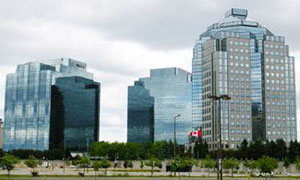A significant legal precedent has been set in Canada that could solve a big problem – the many millions of birds that are killed every year when they collide with glass buildings.
A Canadian judge charged one of the country’s biggest commercial property owners – Cadillac Fairview – with violating the Environmental Protection Act and the federal Species at Risk Act.
The judge found that hundreds of birds were killed in just one year during migration, including threatened species, at three office buildings at Yonge Corporate Centre in Toronto. He ruled that both laws prohibit the emission (intentional or unintentional) of reflected light where that reflection causes the death or injury of birds.
"This is a significant development in an increasingly serious issue that is gaining more attention worldwide – the impact of man-made structures on wildlife, especially birds, and the need to modify existing buildings, as well as incorporating bird-friendly design into new construction," says Dr. Christine Sheppard of the American Bird Conservancy.
Because Cadillac Fairview agreed to address the problem it was acquitted of charges. It installed window films on the most lethal side of the complex at a cost of over $100,000 and will do the same on the rest of the complex.
Migratory birds are confused by the light that reflects off glass because they see the reflection of sky and trees. Buildings with highly reflective windows, like those found at the Yonge Corporate Centre, are especially dangerous, although non-mirrored glass can also produce dangerous reflections.

"The judge’s ruling also means the Ontario Ministry of Environment will now be obliged to regulate buildings whose reflective windows are killing birds," says Albert Koehl, an attorney who represented Ecojustice in the case.
Building collision is among the leading causes of bird mortality in the US, killing as many as one billion birds each year. As building designers strive for ever-greater energy efficiency, they tend to incorporate more glass to bring in daylight, and green buildings often emphasize native landscaping, which also attracts birds.
Recently, San Francisco passed Standards for Bird Safe Buildings; several municipalities around Chicago have taken legislative action, and the State of Minnesota is poised to add requirements for bird-friendly design to their sustainability program.
When building designers and developers earn LEED-certification they can now get one credit for a "bird friendly building."
Download Dr. Sheppard’s Bird-Friendly Building Design:
